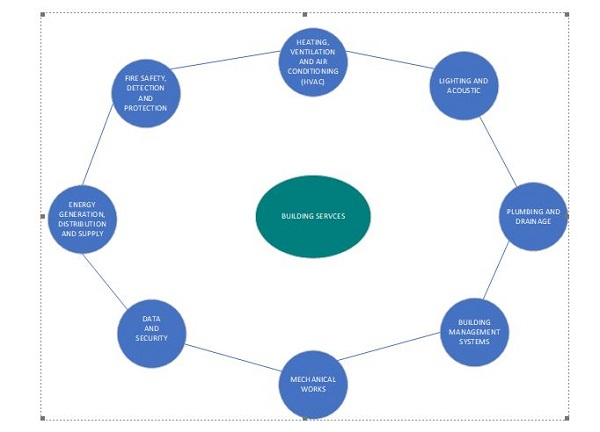Business Features of Tuesday, 16 July 2024
Source: Dr Ernest Kissi, Contributor
Building Services in the Building Construction Industry: Let's pull the trigger on cost escalations
Introduction
Building services are an indispensable component of building construction, processes, and operations, as they are essential for the functionality of any structure. These services do not only contribute significantly to the design of a building but also ensure that required standards are met in accordance with building codes and clients' specifications.
Parameters for building services span from the initial design phase to installation, operation, and maintenance throughout the building's life cycle. In recent times, the requirements for building services have become increasingly sophisticated, driven by advancements in artificial intelligence, the Internet of Things, and other technological innovations.
Moreover, the implications of climate change and the growing emphasis on sustainability have had a profound impact on building service work. Society's evolving needs and preferences also play a significant role, as there is a constant demand for new lifestyles such as environmentally friendly practices. As a result, building services have become more complex, leading to significant variations in project costs.
While there is no fixed threshold or industry benchmark for the cost of building services, it is evident that these expenses can be substantial. In fact, expenditures related to the installation of building services can consume up to half of the overall construction budget.
In cases where extensive services are required to meet the functionality of the building, this cost can escalate even further, reaching up to 75% of the total construction budget. However, more conservative estimates suggest that building services costs may range from as low as 15% to as high as 70% of the construction cost, depending on the complexity and sophistication of the building's design.
In recent times, building services have been a major component in building projects with the highest cost in terms of components and parameters. The highest can cost more than a hundred percent of the overall project cost. If these escalating expenses are not effectively managed, it poses a significant threat to the viability of construction projects.
Therefore, it is crucial for stakeholders in the construction industry to carefully assess and control the costs associated with building services to ensure the successful completion of projects within budget constraints.
To this end, stakeholders continue to express dissatisfaction with the alarming frequency of such incidents. Professionals including quantity surveyors, service engineers, architects, and structural engineers find themselves under pressure as clients fail to grasp the growing trend and consistently demand explanations. Researchers assert that there must be a resolution to this ongoing phenomenon.
What is Building Services?
Building Services have undergone continuous evolution, encompassing a wide range of essential requirements aimed at enhancing the safety, comfort, eco-consciousness, and sustainable utilization of structures. The term Building Service Engineering (BSE) is commonly used in Ireland, Canada, the United Kingdom, and Australia. It is alternatively referred to as Mechanical, Electrical, and Plumbing (MEP) in the United States of America (USA).
In Ghana, it is occasionally labelled as Building services, incorporating traditional elements such as Mechanical, Electrical, and Plumbing (MEP).
In architecture, Building Services encompass the various systems and services essential for the smooth functioning of a building. These non-structural functions include plumbing, HVAC (heating, ventilation, and air-conditioning), electricity, energy conservation, security systems, data systems, elevator maintenance, and accident prevention mechanisms within buildings.
It is worth noting that, plumbing is a comprehensive field that encompasses various methods, materials, and components used in the installation, maintenance, expansion, and modification of piping systems, fixtures, devices, and other plumbing-related elements. These elements are associated with tasks such as sanitation, liquid waste disposal, stormwater drainage, ventilation, as well as the supply of both public and private water systems.
Evolution of Building Services
In terms of basic services, buildings typically require provisions for water supply, electricity, wastewater management, refuse collection, sewage disposal, telephone connectivity, and antenna supply. Considering the early cave dwellers, they lacked these services within their caves, limiting their use of the cave primarily to sleeping. Any other activities had to be carried out outside the cave.
During the 1960s, building services engineers were primarily regarded as specialists in specific areas such as heating, ventilation, electrical engineering, or air-conditioning. The notion of a unified discipline that encompassed a diverse range of technical engineering skills was still distant at that time. However, by 1978, a significant shift in perception began to take place. Building services engineers started assuming a more pivotal role by providing essential and complementary services to architects, structural engineers, and cost consultants.
Fast forward to the present day, from 2008 onwards, there has been an increased emphasis on the sustainability, commercial viability, and aesthetic aspects of buildings. This shift has elevated the status of services engineers, making them key members of project teams. Unlike in the 1970s when they were often appointed last, services engineers are now among the first professionals considered when clients are structuring their teams and assessing project requirements.
Consequently, the professional status of building services engineers has been positively impacted, with their advice and expertise being highly valued. And with the ever-increasing introduction and off new technology almost now and then, the field is expected to see even more metamorphoses.
Figure 1 illustrates the central role of all building services in modern construction practices, emphasizing their importance in ensuring functionality and sustainability.

Professionals in Building Services
Building Services Professionals are responsible for planning, designing, monitoring, and inspecting systems in a building. They give advice on matters related to building services and negotiate and develop construction project contracts. There are many different types of building services engineers, each with their own area of expertise.
Electrical engineers are responsible for designing and installing electrical systems, while facade engineers focus on the exterior of buildings. Heating, ventilating, refrigeration, and air conditioning (HVAC) engineers oversee the climate control systems, and lighting experts ensure that buildings are adequately lit.
Mechanical engineers handle the plumbing and mechanical systems, and public health engineers ensure that the water and sewage systems are up to code. Sustainable and renewable energy engineers are responsible for finding ways to power buildings using clean and renewable energy sources. In Ghana, building services professionals are mechanical and electrical engineers who are normally affiliated with the Ghana Institute of Engineers and the Institution of Engineering and Technology.
Cost Implication of Building Services
In many respects, the design of building services has a more significant impact on the overall design of the building than any other aspect. As such, the building services engineer must work closely with the architect and other design team members from the onset. This complexity demands the recruitment of capable human resources who understand the intricacies of the design and building process.
Notwithstanding, the known traditional components of building services requirements in building projects, the increased technological advancement and digitalization of system components, the application of the Internet of Things, and building information modelling, among others, have widened the extent and technical intricacies of building services.
In addition, new building materials have significant advantages in advancing contemporary construction activities. These technological advancements in the construction industry have massive cost implications on construction costs. An unchecked application of these new tools poses significant cost overrun risks in the construction industry.
The substantial sophistication in modern buildings with a wide range of building services has spiked the concern of critical players in the construction industry, demanding an efficient and effective cost management system. Clients' major question is how to achieve value for money in building services work. The painstaking questions that keep lingering among stakeholders are:
• What major causes account for such substantial cost variations in building services?
• What are some practical solutions to building service cost escalations?
Causes of the Cost Variations
• Duration of Project
The duration of a building services project can vary significantly depending on various factors such as the size and complexity of the project, the scope of work involved, the availability of resources, and the efficiency of project management.
Building services typically include installing and maintaining systems such as HVAC (heating, ventilation, and air conditioning), plumbing, electrical, fire protection, and other essential building infrastructure. It is important for project managers to carefully plan and manage each stage of the building services project to minimize delays and ensure timely completion.
Regular communication, risk assessment, and contingency planning can contribute to successful project outcomes. The specific duration for a project can only be accurately determined after a detailed assessment of the project's unique characteristics and requirements. Most projects' duration in the Ghanaian construction environment is mostly extended, and the actual completion period is constantly confronted with design changes, delays in payment, poor planning, and other force majeure. This generally makes the initial cost of building services much higher at the end. However, the first fixing cost is sometimes not higher than the initial cost. It must be noted that all these have tendencies to influence the cost of the building service in terms of the cost.
• Changes in project specifications
Changes in specifications during a building services project can significantly impact costs. When specifications change, it often involves alterations to the original design, materials, equipment, or scope of work. To manage the impact of changes in specifications on building services costs, it is crucial to have a robust change management process in place. This process should include clear procedures for assessing the implications of proposed changes, obtaining approvals, and documenting any associated cost adjustments.
Effective communication among all stakeholders is also essential to ensure everyone is aware of the changes and their potential impact on the project budget and timeline. Clearly, most clients (private and public) are now sophisticated and have a higher demand for new ways of doing things. When it comes to clients' demands, it is never-ending; hence, project specifications are mainly changed to suit their demands, increasing the cost of the overall project. Thus, building services costs are affected by this demand due to the evolving nature of all building service requirements.
Modern demands for smart apparatus in the building have led to an increasing phenomenon of change in building service specifications. Such that consultants on most projects need to pull the trigger to stop the end of those changes in building service. On some occasions, they are left with no option, but to clients with great changes in building services expressly, even if they disagree, the question is your advice not taken, but the instruction is, I want this!!!
• Smartness of Building Service Component
Incorporating smart technologies in building services can have short-term and long-term effects on construction costs. While initial costs may be higher due to the investment in smart technologies and their integration into the building, the long-term operational and maintenance benefits can contribute to overall cost savings.
In summary, the smartness of building services can impact construction costs, with higher initial investments in technology and integration. However, the potential for long-term operational and maintenance savings, energy efficiency gains, and improved occupant satisfaction can contribute to a positive economic outcome over the life of the building. It's essential for project stakeholders to carefully weigh the upfront costs against the expected benefits and consider the project's overall goals and priorities.
• Competencies of Building Service Professionals
Competencies of building service professionals have a significant impact on the cost of construction. Building service professionals, including, engineers and other specialists involved in designing and implementing building systems, play a crucial role in ensuring a construction project's efficiency, safety, and functionality.
The competencies of building service professionals are interconnected and collectively influence the overall cost-effectiveness of a construction project. Investing in a skilled and knowledgeable team can lead to well-executed projects that meet performance requirements while minimizing construction costs and maximizing long-term value.
a) Design
It is argued that designers of building services often lack the necessary knowledge and training to design these specific services. In various academic institutions, there are no dedicated programs to educate and train professionals in this field. Furthermore, opportunities for continuing professional development (CPD) to update their understanding are scarce.
In a typical construction project, building service professionals come from diverse specialties such as electrical engineering, Mechanical engineering, telecommunication engineering, and civil engineering among others. Many of these designers receive limited formal training and instead acquire skills through on-the-job experience, leading to a reliance on trial and error and multiple design iterations. Consequently, installations often require significant rework, resulting in cost variations.
Only a small number of building services designers possess graduate-level education in this area and pursue professional recognition through exams offered by organizations like the Ghana Institution of Engineering and the Institution of Engineering and Technology. However, these exams lack clarity in terms of specific building requirements and practicality.
Additionally, these organizations responsible for conducting the exams do not provide sufficient guidance or accreditation for building services practitioners. As a result, there is a noticeable disconnect between the design phase and the installation of mechanical, electrical, and plumbing (MEP) systems and others, which poses significant challenges for the cost estimation process.
b) Cost Estimate
The responsibility for quantification of buildings, financial management services, and cost consultancy has traditionally rested solely with Quantity Surveyors. The impact of building services on the operational cost of buildings necessitates that Quantity Surveyors possess the skills and knowledge to effectively measure Mechanical, Electrical, and Plumbing (MEP) elements within a building.
Despite their primary role in quantifying MEP elements, Quantity Surveyors have been less involved in providing these services due to their limited competence in this field. It is argued that the consequence of this insufficient knowledge in quantifying MEP services is the widespread use of blanket Prime Cost Sums without providing a detailed breakdown.
Instead, the responsibility is often deferred to MEP engineers or contractors. Quantity Surveyors encounter challenges in providing standard base quantities for MEP due to the increasing complexity of MEP design in building projects. Consequently, this results in significant discrepancies between tender sums and the final project cost. In simple terms, the MEP knowledge of Quantity Surveyors is insufficient.
• Building service documentation
Effective documentation in building services is of paramount importance for managing and controlling construction costs. It ensures clarity, transparency, and accountability throughout the construction process. Collaborative efforts among project stakeholders, including architects, engineers, contractors, and project managers, are necessary to establish comprehensive building services documentation. Regular updates, reviews, and a systematic approach to documentation are vital for cost control and successful project outcomes.
Unfortunately, during the initial stages of a project, insufficient attention is often given to most Mechanical, Electrical, and Plumbing (MEP) elements since their work is typically scheduled for later stages. Consequently, there is a tendency to overlook crucial details, calculations, and extensions within the agreements.
Remedies for the Cost Variations
Upscaling of QS and Building service professionals
a) Educational Training on Building Services
There is a need for continuous advancement in the educational training provided to quantity surveyors regarding building services. Curriculums must be refined to integrate end-user feedback and the industry (Clients, Contractors, and Consultants).
Clients, contractors, and consultants should be engaged by universities when reviewing program objectives. The coursework can then be strengthened to address the full spectrum of technical capacities required in the workplace.
Universities can partner closely with industry experts to regularly review and update course content and materials for building services courses. This ensures that QS students are equipped with the knowledge and skills to understand and apply the latest systems, technologies, methods, and cost management approaches used in the building services industry.
This comprehensive approach ensures that graduates are prepared to meet the evolving demands of the field and contribute effectively to the success of construction projects. Also, having lecturers well-versed in the technical aspects of M&E measurement is essential for knowledge transfer. Universities can recruit or assign lecturers with industrial experience using the latest standards and techniques.
Furthermore, maintaining the expertise of Lecturers in the university requires continual professional development support. This keeps academics abreast with technical and process innovations, ensuring students graduate equipped with state-of-the-art technical skills.
b) CPDs for QS & Service Engineers.
Professional bodies such as the Ghana Institute of Surveyors (GHIS), Ghana Institute of Contractors (GIOC), Ghana Institute of Engineers (GHIE), and Ghana Institute of Architects (GIA) can have a role to play through organizing development programs for their members. Continual professional development (CPD) seminars focusing on specialized Building Service topics such as Building Management Systems, Building Information Modelling, and renewable technologies allow practitioners to enhance their technical skills.
Construction firms can complement academic and CPD training by sponsoring quantity surveyors to obtain additional knowledge in the universities or appropriate conferences. When quantity surveyors are well-versed in measuring building services and cost control during the construction phase, there shall be lesser cost variations to the client.
• Use of Measured Quantities
In proposing a solution to the cost estimation problems associated with building services, incorporating engineering services as measured quantities instead of relying on Prime Cost Sums leads to improved cost estimate performance. Adopting this strategy underscores the necessity of training Quantity Surveyors better.
In analyzing the superior proficiency of the contractor’s quantity surveyors in providing expert advice on cost management, it was identified that the contractor’s QS is continuously involved in the preparation of claims, interim valuations, progress reports, and final accounts that are critical channels for the acquisition of MEP knowledge.
The research further acknowledges that consistent engagement with the services engineers, subcontractors, and craftsmen offers a robust environment for the acquisition of skills, knowledge, and the on-site intricacies of MEP installations. To boost the know-how of the Quantity Surveyor from the consultancy end, regular site visits, training, and interactions with the onsite personnel are essential to better understand MEP quantification.
• Design verse Firming up Budget
Generally, it is advisable and imperative for stakeholders to firm up the budget of a given project concerning the given design. Firming up the budget for the project helps the project manager manage the project within a limit of the money for the project.
It is, therefore, imperative for the trio, the architects, service engineers, and quantity surveyors to agree on the design of the building, service designs, and cost thereof. To achieve efficiency and effectiveness in the price of the MEP, there is a need for an approved budget for the project. Therefore, Stakeholders are advised to ensure that this is always achieved in the project setting before the actual work starts.
• Clear Communication Channels on MEP
Clear communication channels on Mechanical, Electrical, and Plumbing (MEP) systems are essential for successful building construction projects. Effective communication ensures that all stakeholders, including architects, engineers, contractors, and project managers, have a shared understanding of MEP requirements, specifications, and timelines.
Firstly, establishing clear lines of communication between project stakeholders facilitates collaboration and coordination throughout the project lifecycle. Regular meetings, progress reports, and project updates enable stakeholders to address any issues or concerns promptly, preventing misunderstandings and delays. Secondly, utilizing modern communication technologies such as project management software, email, and virtual meetings enhances communication efficiency and transparency.
These tools enable real-time communication, document sharing, and tracking of project milestones, ensuring that everyone remains informed and aligned with project objectives. Moreover, assigning clear roles and responsibilities to each stakeholder regarding MEP systems fosters accountability and ensures that tasks are completed on time and within budget. Clarity on who is responsible for MEP design, installation, and maintenance helps prevent confusion and avoids duplication of efforts.
• Incorporating Value Management in the MEP Design Process
Incorporating Value Management (VM) into the Mechanical, Electrical, and Plumbing (MEP) design process enhances efficiency and cost-effectiveness. VM focuses on maximizing value while minimizing costs by identifying and prioritizing project objectives, functions, and requirements.
During the MEP design phase, VM techniques such as value engineering workshops can be used to brainstorm innovative solutions that meet project goals while optimizing resources. By involving key stakeholders, including designers, engineers, contractors, and clients, VM ensures that all perspectives are considered, leading to well-informed decisions and improved project outcomes.
Furthermore, VM encourages continuous evaluation and refinement of design proposals to align with project objectives and budget constraints. Through value analysis and cost-benefit assessments, alternative design options can be explored to identify the most cost-effective solutions without compromising performance or quality. Ultimately, integrating VM into the MEP design process promotes collaboration, creativity, and efficiency, resulting in optimized designs that deliver maximum value to stakeholders while minimizing unnecessary costs.
Conclusion
Construction projects globally are facing significant disruptions in pricing, necessitating stakeholders to continuously update their pricing knowledge to ensure value for money. Stakeholders must identify any factors contributing to cost escalation, understand the underlying reasons, and implement suitable solutions. Particularly, the costs associated with mechanical, electrical, data and security, and plumbing (MEP) services have emerged as major barriers to achieving effective and efficient project completion within budget constraints.
This piece has outlined various causes of cost escalations in MEP services and proposed solutions to address these challenges. By addressing issues such as project duration, changes in project specifications, smart technology integration, professional competencies, and building service documentation, stakeholders can effectively manage construction costs and achieve project objectives.
Enhancing the competencies of building service professionals, particularly in design, cost estimation, and documentation, is crucial for managing construction costs effectively. Continued education, training programs, and collaboration among professionals can improve skills and knowledge in MEP services, reducing errors and cost overruns.
Proper documentation of building services is essential for managing and controlling construction costs. Collaboration among stakeholders and systematic documentation approaches ensure clarity, transparency, and accountability throughout the construction process, contributing to successful project outcomes.
Overall, by addressing these challenges and implementing the proposed solutions, stakeholders can effectively manage cost escalations in MEP services and ensure efficient project delivery within budget limits. Continuous improvement in project management practices, stakeholder collaboration, and professional development are key to achieving cost-effective and successful construction projects.
The writer, Dr. Ernest Kissi is a Senior Lecturer, Department of Construction Technology and Management, Kwame Nkrumah University of Science and Technology, Kumasi. Special acknowledgement goes for Prof Gabriel Nani, Mr. Amoako Chief Michael and Mr. Abdul Razak Shamsu-deen for their editing.











